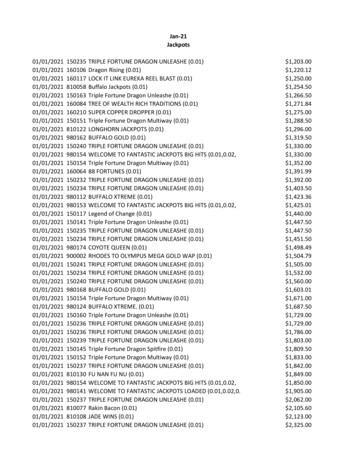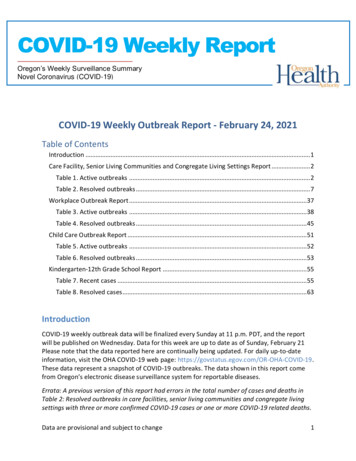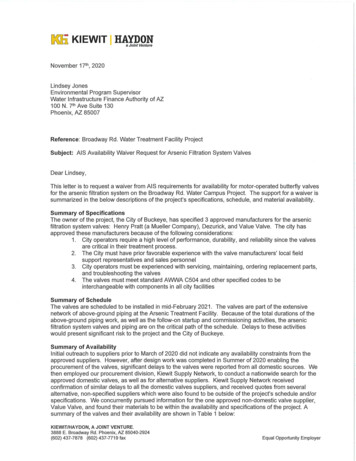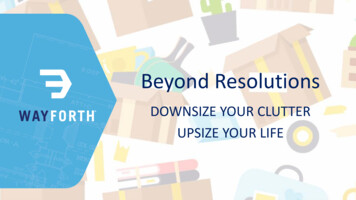
Transcription
WomensNet 2021 Guide toJumpstarting Your MarketingProven Ways You Can Find and Attract Customers Fast
Table of ContentsIntroductionSearch EngineOptimization (SEO)SEO BasicsGrassroots MarketingKeywordsImproving Your RankingCreating AwarenessOn-Page SEONetworkingOff-Page SEOOutreachTechnical SEOSite PerformanceYour WebsiteChoosing Your Online AddressDesign BasicsContent Management SystemFunctionalityOffering a FreebieConversion RateOptimization (CRO)Earn TrustBe Clear and ConciseGet and Keep AttentionReduce FrictionFocus on UsabilityTEST TEST TEST
PublicityLinking Publicity and SalesTypes of Media OutletsWho Cares?The Two-Pronged ApproachAdvertisingWhere to AdvertiseTypes of AdsDigital Search AdvertisingResourcesReferencesFurther Reading 2021, WomensNet. All rights reserved.
IntroductionThere are many reasons businesses aresuccessful. Some have superior or innovative products and services. Others havetop talent on their payroll. Some developan efficient infrastructure that keeps costslower than the competitions’, while othersare more concerned about delighting everysingle customer.No matter what your competitive advantage, the one thing every company needsis a solid base of customers willing to paytheir stated prices.And the only way to find and sell to thosecustomers is through marketing.The good news is that, no matter whatother people may have told you, marketingdoesn’t have to be complicated or expensive. Our WomensNet team knows thisthrough more than 100 years of combinedmarketing experience.offer you advice, ideas, and encouragement, hence the genesis of this marketingguide. We wanted to create somethingto help women business owners generatemore business, make more money, and bemore profitable.The marketing ideas on the follow pagesare offered as proven tools you can use toconnect with your target market—your potential customers. We’re not experts in yourindustry, but we’ve seen these tactics workwell in a number of different markets. So,we’re providing them as ideas for you to try,tweak, and make your own.Some will fit better than others, dependingon your industry, customer base, location,and budget. But, we hope that you’ll findsome new ideas you can use to bring inmore business.The trick is determining which marketingmethods are the most effective at attractingthose paying customers on a regular basis.Some may be effective initially but thenquickly taper off, while others are slow andsteady. Typically, you won’t know right awaywhich are going to work best for you—youmay need to try a few different approaches and compare results before you decidewhich to should invest in heavily.At WomensNet, we’re here to help youbuild a successful business. We want toPhoto: Congratulations to our monthly and annual Amber Grant winners from 2018 and 2019.5
Grassroots MarketingMarketing doesn’t have to cost a lot ofmoney and, in fact, some of the most effective approaches are the least expensive.That’s especially true of grassroots marketing methods.Sometimes referred to as “guerrilla marketing,” a phrase coined by Jay ConradLevinson years ago, grassroots marketinginvolves using low-cost or no-cost approaches to connect with people and introduce your business. This type of marketingworks especially well for locally focusedbrick-and-mortar businesses, like retailstores, beauty salons, florists, daycare centers, fitness facilities, and restaurants, forexample.Any kind of business can use grassrootstechniques, but local companies typicallysee the best results, mainly because theirtarget market is so well-defined by their geography. It’s very easy to identify how manyhouseholds there are within a 2-mile radiusof your business, for example, and to trackdown the name and address of the homeowners. That’s helpful information whenyou’re trying to invite everyone to a specialevent.Grassroots marketing is highly targeted andtherefore can generate great results.Photo: July 2019 Amber Grant winner LoveAgain Local café offers dining, catering, andplant-based cooking classes.Creating AwarenessFor many local businesses, the path to success starts in making sure everyone in yourarea knows what you sell and to whom.Awareness is the first challenge to overcome. Fortunately, there are a number oflow-cost ways to increase awareness: Introductions. Walk in and introduceyourself to the other business owners onyour block or in your neighborhood. Tellthem what you sell and invite them tostop by to check your operation out. Business cards. Post your business cardon bulletin boards in area restaurants,community centers, and businesses thathave such a spot (Panera, for example,seems to have them in most locations). Door hangers. If your company provides an in-home service, such as cleaning, window treatments, or organizing,printing up your information on a rectangular tag that can be hung on a frontdoor knob can be very effective. Signage. Putting up signage that clearlyidentifies your business on the buildingand along the road, for example, willinvite customers to find you. Don’t skimphere, this really matters if you have acustomer-based business. Think “clearand classy” over “loud and clever.”7
Grassroots Marketing Sponsorships. Depending on your marketing budget, this might not be a tacticyou can afford right out of the gate, butgetting your company name on a bannerat an event or on local sports team jerseys is a nice way to elicit positive feelings and raise awareness. As far as ROIgoes, it’s pretty low, however. So, don’tinvest in sponsorships expecting to netlots of business.Networking Classes. Most libraries offer free andpaid classes to the community. Considerdeveloping a 60 or 90-minute presentation that introduces people to yourproduct or service in a way that teachesthem something. A home builder couldteach a class on designing your dreamhome, a laundromat could offer the besttechnique and products for cleaningyour clothes, or a garden center couldteach a wreath-making course. Be educational and creative. Civic organizations. Join local organizations, like Rotary, Kiwanis, or the Elks, toconnect with other civic-minded leadersin your community. Leverage friends and family. This is theharsh reality: if you’re starting your ownbusiness, you probably have more marketing sense than the intern most agencies will put on your account. Talk toyour friends and family about ways theycan help get the word out. There usuallyisn’t a magic bullet, just good decisionsand elbow grease.Look for local opportunities where you cantalk about your business, demonstrate yourexpertise, and/or invite people in to experience what your company offers. That’s thefirst step in gaining awareness.8Once your market is familiar with your business, another great grassroots marketingtechnique is networking with colleagues,suppliers, industry leaders, and fellow business owners. The more people who knowyou and like you, the more business you’relikely to see come your way. Some of theeasiest ways to network include: Business groups. There are also localorganizations that bring together members of the business community, such asthe Chamber of Commerce or an association for your particular industry. Your school’s alumni association. Ifyour business is located in the city whereyou went to high school or college,make sure to become active in thesegroups. You’ll reconnect with peoplewho knew you years ago and may wantto support you as a local business owner. Tip clubs. Look into joining tip clubs, orleads groups, which meet regularly forthe sole purpose of exchanging businessnews and leads. BNI was the pioneer inthis area, though there are likely othergroups in your town. Partnering. A great way to connect withprospects who are highly likely to needyour products or services is to partnerwith complementary businesses. Poolyour resources and agree to market toeach of your mailing lists. For example,
Customer Servicea wedding photographer might partnerwith a wedding cake bakery, or a graphicdesigner could partner with a commercial printer.is Crucial to Word-ofMouth MarketingThe truth is, you come across networkingopportunities on a daily basis. Anyonestanding near you at a meeting or sittingnext to you on a plane is a potential customer, so strike up a conversation and introduce yourself.It’s hard to overstate the importanceof stellar customer service.OutreachAccording to Temkin Group, 77% ofcustomers would recommend a brandto a friend after having one positiveexperience.In addition to raising your company’s visibility and making a habit of networking witheveryone in earshot, there are also someinexpensive things you can do to entice aprospect to consider doing business withyou. These include, but aren’t limited to: Newsletters and email marketing.Sending out regular information aboutyour company and tips related to yourproducts or services is a great way tocontinue to raise awareness and educateyour market. Although electronic newsletters, such as through Constant Contact or Mailchimp, are the most common, a printed newsletter might have abetter chance of getting read if it landsin your prospects’ mailbox at home.(Trader Joe’s has stuck with its paperflyer with product information despiteeveryone else’s seeming migration todigital.)Consider these survey revelations:American Express found that 90% ofAmericans use customer service as afactor in deciding whether or not topurchase from a company.And per Nielsen, 92% of consumersbelieve suggestions from friends andfamily over other advertising.The consequence of not prioritizinggreat customer service—across allsupport platforms—is clear. All it takesis one negative review to hurt ROI, sotake customer questions, feedback,and complaints seriously. Once you’reestablished, consider surveying customers to make sure you’re not missing growth opportunities.Now, we understand—customer service probably isn’t the first thing youthink about each morning. But it’scritical to your business’ bottom line.If you’ve built a company with thecustomers’ needs at heart, excellentcustomer service really isn’t very difficult. It merely takes a concerted effort.9
Grassroots Marketing Sampling. One way to overcome aprospect’s reluctance to commit to anew product or service is to offer a freesample. This works just as well for professional services as it does for the foodproducts you see set out at little tablesinside grocery stores on the weekend.Beauty manufacturer Clinique pioneeredthe free-gift-with-purchase, which is yetanother way to entice customers to trynew products they may not purchaseotherwise. Special event. Any business can have aparty, but if you can create an event thatdemonstrates your products, so muchthe better. Clothing retailers sometimesschedule trunk shows and invite theirbest customers to a mini fashion show.Gift shops invite their artisans in for technique demonstrations, and bookstoresoften schedule book signings. Thinkabout what your customers would like toexperience or learn and invite them in todo just that. Contest. Everyone loves the chance toget something for free. It’s important,though, to be clear on what you wantto achieve before getting started. If youwant to build your mailing list, you’llwant to collect contact information aspart of the entry. If you want people tocome to your business, you could require an in-person entry. And if you wantto collect testimonials, you’ll want to askfor customer success stories to be entered. The more your prize package isfull of desirable products and services,the more successful you’ll be.10 Social media. In terms of cost-effectiveness, social media platforms havethe potential to be excellent tools forsharing information and building a community. By setting up free accounts onFacebook, Instagram, Pinterest, Twitter,LinkedIn, or Reddit you can share newsand photos related to your business andannounce upcoming events and promotions. You can create members-onlygroups and share inside tips and information with interested individuals.Whole books have been written aboutmarketing with social media, but themost important thing to remember isthat you don’t own any of the information on the platforms. If your accountgets deactivated or your group shutdown, you have no recourse. So, makesure you drive people from Pinterest orFacebook to your website so that youcan continue to build that relationshipwith them.Before investing time here, really sitback and think about the right platformfor your product. Pick one platform anddo it well; don’t try to do all of them atonce. As always, use common senseover pie-in-the-sky strategies. Ask yourself, is my target audience really on thisplatform, and if so, how can I be of valueto them to build credibility?Investing time and resources in outreach isan important step in connecting with yourprospects and customers and persuadingthem to give your business a try, either bystopping in to shop, trying a sample, ordirectly buying from you.
Advice to Aspiring Female Entrepreneursfrom Past Amber Grants WinnersKelly TwichelRebecca ScottI would tell anyone who wants to start theirown business that it will seem overwhelming, but it is achievable. Staying organizedand finding the right mentors will help youimmensely. I think I’ve used the SCOREresource (Service Corps of Retired Entrepreneurs) 20 times in the last year for things likemy business model, taxes, partnership questions, and sales and distribution. Also, don’tforget to set aside time for yourself! Finally,have fun sharing and celebrating your little(and big) victories with friends and family.A really wise entrepreneur once told methat, in business, the first “no” means, “niceto meet you, now we’re having a conversation.” This piece of wisdom could not bemore true. It is extremely important to betenacious and nimble as an entrepreneur.As a start-up founder, and particularly as afemale, you will be underestimated and told“no” the first time you approach new customers. However, by creatively following-upand finding other ways to get in touch,you will find it is possible to turn a “no”into a “yes.” Many of the milestones I haveachieved for Sustainable Snacks have comeafter multiple attempts to open a conversation. In business, persistence pays off!Co-Founder of Access TraxChantal EmmanuelFounder of Sustainable SnacksCo-Founder of LimeLoopThe quicker you can shed any fear or nervousness you have around seeking guidance, gathering advice, and asking for helpfrom those both in and out of your network,the better you and your company will be.Just remember to pay it forward when thetime comes.
Your WebsiteMost businesses today are critically dependent on their websites for marketing.This is true whether you run a locallyfocused venture or a global corporation.Because consumer habits are now so relianton the internet for information, much of thepurchase decision is made through information-gathering conducted online.Before anyone calls to schedule an appointment for a consultation, decides ona product to purchase, or stops in to buysomething, it’s very likely they did a Googlesearch. If you have a website with usefulinformation on it, Google may have suggested that your potential customer takea look at it—depending on where it falls inGoogle’s ranking of websites in your space.Your website is your business’ front door.It provides the first impression of yourcompany and of the goods or services yousell, which is why it’s so important that 1)you have a website and 2) the appearancematches the image you’re going for. It’salmost impossible to be successful withouta website.If you don’t have a brick-and-mortar store,your website is much more than a brochureor catalog—it’s your business’ lifeline. Youhave to get potential buyers to your site(with SEO), create a great user experience,and convert people into paying customers(with CRO).Choosing Your Online AddressIdeally, the online address customers use tofind your company features words relatedto your business name. That is, your business URL matches the company name, orsomething close to it.For example, if your company name is Duncan Transcription Services, the best URL youcould buy would be duncantranscriptionservices.com or duncantranscription.com. Oran even more powerful URL might includeyour city or town like chicagotranscription.com. That way, anyone searching for “Chicago transcription services” would matchyour URL. Trying to be clever with phraseslike “recordingsintotype.com” or “wehearyou.com” will only backfire and make itharder for Google to connect your URL withwhat you do.Most people search for a service or aquestion first, so keep that in mind as yousettle on a URL.If your company name isn’t available with a.com suffix, you have a few options, including: Using a hyphen to separate the words,such as Duncan-transcription-services.com. Other separators, such as signsPhoto: 2018 year-end Amber Grant winner Kristen Moffatt, owner of Wasatch Nectar.13
Your Websiteor (underscoring), are unrecognizableand don’t serve their intended purpose.Stick with a hyphen to create phraseswithin URLs. Opting for a suffix that is not .com, suchas .net. Don’t get too clever with thesuffix or people will get confused. Adding another word, such as duncanmedicaltranscription. Adding your location, as in duncantranscriptionfl.com, if you were in Florida.Online buyers are likely to search for abusiness like yours in their local area. Somake it clear where you’re located byadding your town, city, or neighborhoodname on a page or two on your site. Abbreviating some of the words, such asduncants.com, where the ts stands fortranscription services. Breaking up your business name using alesser-known suffix, such as Delicious didwith del.icio.us. Google doesn’t recommend this approach, but it is a possiblesolution nonetheless. Using a domain broker to try to buy it(GoDaddy has a fairly user-friendly one).This can get very expensive very quicklyand may not be worth a big outlay ofcash.Design BasicsThere are many schools of thought regarding effective website design, but unlessyou’re a graphic designer, your best approach is to hire a professional designer14(expensive!) or to use a design templatethat another skilled designer has alreadydeveloped (smart!).Trying to put together even a simple website takes training; you’ll shoot yourself inthe foot and make a bad impression if youdecide to cobble something together onyour own. You want to look professional,not handmade. As you evaluate differentdesign approaches, consider: Your target market and how computersavvy they are What image you want to present (ex:whimsical, conservative, innovative) Your brand colors and the colors that willcomplement them The different things you want visitors tobe able to do (learn more about you,the company, your process, contact you,take a quiz) What you want site visitors to do afterarriving—typically you should have someCTA or call to action (download a freereport, schedule a consultation, buy aproduct, read an article)Those decisions will then inform the visualsof your site, including: The overall look and feel Colors and type style Essential navigation buttons Need for e-commerce capabilities
Your WebsiteColorcan increase brandrecognition by80 percentImage: The logo colorchoices of top companies.Source - Canva.comContent Management System(CMS)Based on our experience, for DIY, we generally recommend Wix or Weebly for basicwebsites and Shopify for e-commerce platforms.If you are hiring a freelancer or agency,Wordpress is usually best.A few popular but pitfall-filled CMSs toavoid include: Joomla, Magento, and DNN.Drupal and Expression Engine are usuallyoverkill and will cost you more money thanyou’d pay for the same site in Wordpress.Avoid any proprietary agency content management systems.FunctionalityDifferent websites have different purposesand, therefore, different functionality.Many websites built using Wordpressthemes or templates are basically blogswith additional information. There isn’tmuch functionality beyond being able to fillout a Contact Us form. That may work finefor your business, especially if your site’spurpose is to share product or service information as a step toward getting an in-person appointment.Other companies may need more capabilities, such as: Newsletter sign-up form15
Your Website Calendar for appointment scheduling Links to social media accounts E-commerce for product sales An FAQ page to answer commonlyasked questionsSome ideas of content formats for yourfreebie include: A checklist A coupon A planner A mobile-ready version of the website A list of resourcesThink about all the information you wantyour visitors to see and rank it from mostimportant to least. Then make sure the design of your site reflects those priorities. An industry reportOffering a FreebieOne of the best ways to attract potentialcustomers to your newly launched websiteis to create something that you can offerfor free, which some people call an “ethicalbribe.”The idea is that you offer site visitors apiece of information or content that will bevaluable to them. You don’t charge themfor it, but you do ask for their name andemail address so you can keep in touchwith them. That’s the trade-off: you givethem information they want and they giveyou permission to follow up.Every business is different and every customer segment has different wants andneeds, even within similar businesses. So,you need to think about what one pieceof information every one of your customers would want. Then design content theywon’t be able to resist.16 A list of potential clients A recipe, or series of recipes Step-by-step instructions for how toaccomplish something Sample dialogue for how to have atense conversationYour freebie doesn’t have to be lengthyat all. It just needs to give your prospectexactly what they’re looking for—and whatyou’ve promised to provide.Many freebies are between one and threepages. And as long as yours helps thevisitor do something faster, better, for lessmoney, or with better results, they won’tcare if it’s beautifully designed and 30 pages long, or simple and a single page.
The Importance ofColor in Site DesignAlways make sure that your websiteconveys the right message. That’s donenot only by the words and images youchoose—it’s also found in your colorscheme.Warm colors like red, yellow, and orange can convey a range of emotionsfrom comfort and warmth to anger andhostility. Cool colors—like blue, purple,and green—spark feelings of calmnessand tranquility, as well as sadnessand solitude.Image: Warm and cool colors on a color wheel.Source - Decoart.comConsider this: research from the Institute for Color Research shows that people make a subconscious assessmentof an environment, person, or productwithin 90 seconds of initial viewing. Between 62% and 90% of their assessmentis based on color alone.Furthermore, according to a study bythe University of Loyola, color can increase brand recognition by up to 80%.Beyond your big picture color scheme,prioritize creating appropriate call-to-action (CTA) buttons. On many sites we’vereviewed, poor contrast between textand background color makes readingdifficult. That’s a surefire way to reduceconversions (and thus, your revenue).Image: Adobe Color offers free color themesbased on current trends and search keywords.While orange and green are popularCTA button choices, there’s no “best”color for your CTA. Instead, prioritizehigh contrast combinations to makeyour CTA stand out.17
Your WebsiteDOs of Website DesignDo think about what your prospective customers actuallywant. They don’t care about yourmission or vision, honestly. Theywant to know how you can helpthem, how you are different fromyour competition, and how to getin touch with you.With that in mind, make sure youhave friends and potential customers use your site to offer suggestions and comments on howto improve the user experience(known as “UX” in the site designindustry). This is a big deal. Themost competent agencies andweb designers take UX very seriously and spend significant timeensuring it’s as good as it can be,both before and after launch.Do look at the competition, seewhat mistakes they have madeso you can avoid them, and findinspiration in what others havedone really well. Look at nationalcompetitors, too. Just becausethey are much bigger than you aredoesn’t mean you can’t learnfrom them.18Do organize your website by howyour customers shop for what you’reselling, not by how you see yourcompany. Think about what yourcustomer may want to do at yoursite. Make it easy for them to findthe product, service, or informationthey’re after. Here’s a big deal: Ifyou’re a brick and mortar operation,make sure your phone number, address and business hours are prominent on your home page. Manypotential customers will “bounce” ifthey have to scroll and click aroundto find basic information.
Your WebsiteDON’Ts of Website DesignDon’t try to do too much. You arebetter off with a one-page websitethat’s clean and clear than a multipage website that has broken linksand is difficult to navigate. Find thebalance of what you can afford todo well.Don’t use stock photography orhomepage sliders. No one readssliders, and visitors want to see realpeople and products. This mightseem trivial, but seeing real pictures of you or your customers andemployees goes a long way towardbuilding trust and credibility.Don’t include a blog unless youare truly going to write valuablearticles for an audience who willactually read them. Sure, you canspend an hour writing about thelatest trends in your industry, butthere are bigger players who cando the same and are already established in the market. Use your timemore wisely and perhaps invest incleaning up your sales funnel or refreshing your website’s language tobetter suit your customers instead.Help your customer or prospectfind what they’re looking for whenthey come to your website. If theycan do it easily, your website is effective. In the long run, that meansmore revenue.19
Search Engine Optimization (SEO)Now that you have a functioning website,it’s time to attract visitors.One of the most important ways to dothat is through search engine optimization(SEO). You’ve probably heard of SEO, whichis, essentially, helping your website appearhigher on the search engine results page(SERP), which is delivered in response to auser query. Because the first few listings onany Google search result page are muchmore likely to get click-throughs than thelistings that are on later pages, you want tobe at the top of the first page of any relevant search to your business. Only 25% ofpeople look beyond the first page ofGoogle results.In fact, Hubspot reports that 57% of B2Bmarketers say that SEO generates moreleads than any other marketing tool.That statistic makes a lot of sense, sinceSEO tactics are designed to bring peoplewho are looking for what you’re selling toyour website. If you do a good job of helping Google understand what your websiteis about and who might be interested inwhat you’re selling, the quality of the leadsyou receive is going to skyrocket. Whenthat happens, you can safely assume thatsales are going to follow more oftenthan not.SEO BasicsTo understand SEO, you need to first understand what Google’s role is. As a searchengine, its sole purpose is delivering resultsto searchers that give them exactly theinformation they’re looking for. It wants toanswer the questions that people areasking.For example, if you’re looking to find outwhere to buy a saltwater fish tank, Google wants to tell you everything you couldpossibly need to know about buying a fishtank and where to get it. It decides whichwebsites do the best job of answering thatquestion for you based on the informationon all the websites that are on the internet.It regularly scans (or “crawls”) websites tofigure out what they’re about. And thenwhen someone asks for information on atopic, Google delivers results in descendingorder from “best to worst,” or most relevant to least relevant.Only 25 percentof people look beyond thefirst page of Google results21
Search Engine Optimization (SEO)Search engines rank websites based on anumber of factors. Although there are anestimated 200 or more, some of the mostimportant factors include: Keywords. Keywords are the words andphrases people use when trying to findspecific information online. The searchengines look to see if your site has thosesame keywords and phrases. Based onthat, it determines how relevant yourcontent is to the query posed by thesearcher. Bounce rate. The bounce rate is basically how quickly people leave your site,and it’s another key metric Google considers. Generally, the longer someonestays on a site, the more likely it is thatthey’ve found what they were lookingfor. Conversely, the faster they leave, thegreater the odds they did not find whatthey were after. Sites with lower bouncerates are considered to be more relevant. Backlinks. These are links back to yoursite from other websites. This demonstrates to the search engine that yourcontent is good and relevant to thesearch. The more backlinks, especiallyfrom high quality sites, the more Googletrusts that yours is a quality site as well. Quality content. Is the information onyour site useful and keyword rich? Doesthe material pertain to the keywordsyou’ve used? Does it answer the questions people are asking? Fresh content. Google also looks athow often you’re adding new, qualitycontent to the site. Websites that reg22ularly add new content are generallyranked higher than those that rarelyor never add fresh content. They areviewed as less up-to-date, and therefore,less relevant.Top 5 Factors for SEO KeywordsBounce RateBacklinksQuality ContentFresh ContentKeywordsSo keywords are important. However,websites don’t rank for keywords; websitepages do. So don’t aim to associate yourwhole website with one particular wor
though, to be clear on what you want to achieve before getting started. If you want to build your mailing list, you’ll want to collect contact information as part of the entry. If you want people to come to your business, you could re-quire an in-person entry. And if you want to collect testimoni










